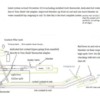Bruce,
The quick and dirty answer is that your stock Subi water pump will likely produce sufficient flow with the 1.5" tubing you suggest. The back story is interesting, to me, but long. As an aside, my experience has shown that, for our platforms, a large volume of cool air to the rad is more important than water pump efficiency.
Car water pumps need to perform under widely varying conditions, with rpm's from 800-900, all the way to 6000 or so. Most models have stamped, open vane impellers with lots of bypass, as there is a fairly substantial gap between the vane end and the housing. Water pump makers don't like to publish data regarding flow, and, when they do, it's not worth much. Example: Gates will state GPM for pump A at 6000 rpm. Interesting, but we don't spend much time at 6000 rpm. My queries were for GPM at 3100 rpm, my cruising rpm for freeway driving. No info available. Someone, somewhere has that data, but I could never find it. Companies likely consider such info proprietary and keep it in-house.
Subaru corporation has also helped to muddy the water pump waters. At various times in the recent past, one of the Subi gurus, like Cosworth or Crawford, produced a "revolutionary" and custom water pump design that eliminates the overheating concerns car guys experience with the old-fashioned stamped vane pump. They merely reproduced an earlier version of the impeller that was cast, not stamped, and had a closer tolerance between the impeller end and the housing. Of course, the "custom" application cost a lot more. When forum members pointed out the similarity to an earlier Subi part, or asked for data to show increased efficiency, they were treated like ungrateful miscreants.
Amateur engineers like us don't have expensive flow meters on the garage wall, or costly engineering tools or the experience to use them efficiently if we did have them. All car guys can do is share their experience. Not surprisingly, most of that shared experience is negative: I tried X and it didn't work. Once in a great while, one of us succeeds.
It's also useful to remember that Subaru designed engine parts for the Subi engine bay, which is in the front of the car where lots of cool air is easy to get. No ducting is needed, and the rad is facing the incoming air directly.
In my Subi cooling research, I learned two important lessons: 1) Subaru engineers are very smart and very talented, and 2) if the accounting department can save a few cents on a specific part, they will lobby aggressively to do so, as those pennies saved multiplied by hundreds of parts times thousands of units means substantial savings to the stockholders. We need to remember that all design changes don't equate to better performance. Sometimes, an earlier model part functions better than its successor.
In addition, don't forget that the real restriction in your cooling system isn't an extra 16' of 1.5" smooth pipe, it's the restriction and back pressure of the rad itself. New rad design is markedly different than the old copper/brass rads of the past. Tubing size, spacing, and shape have all changed in the last decade or so. Dual and even triple pass rads are common, but triple pass rads slow the flow so much that they can actually increase coolant temp, not lower it. Friction loss from the small rad tubes is substantial.
Subi forums in particular, and automotive cooling sites in general, have lots of great info, but lots of nonsense also. Sometimes the smartest guy on line is also a Richard Cranium, so he becomes the center of controversy, instead of the info he presents.
I look forward to your efforts and results, which I know you will share as you have in the past.






